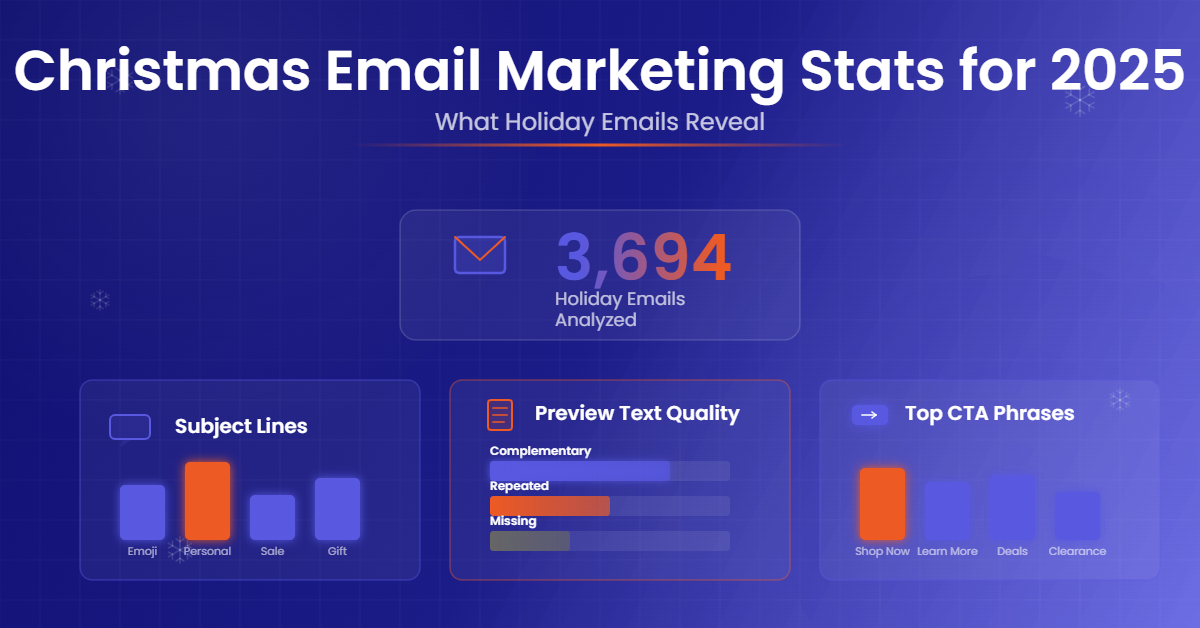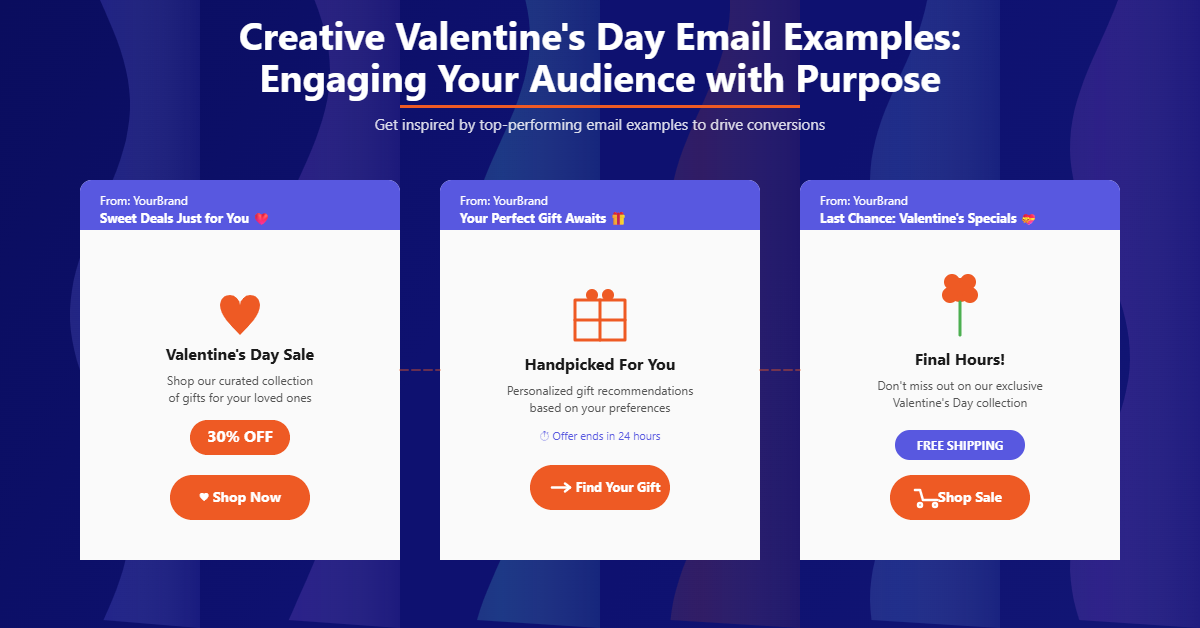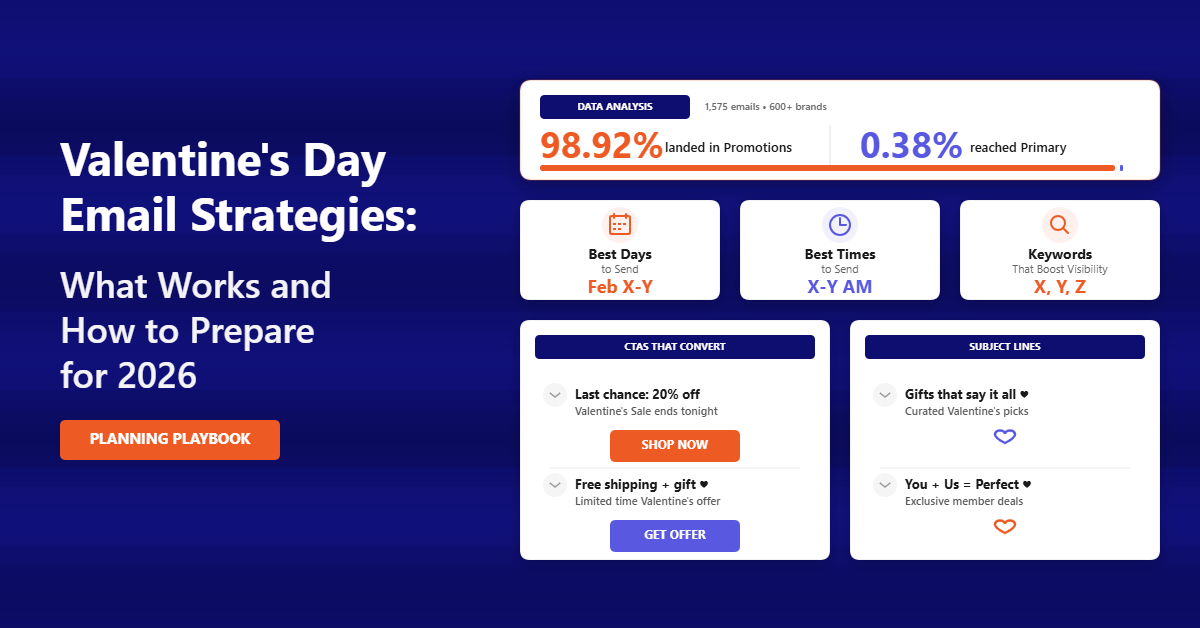In an analysis of 3,694 Christmas emails from 1,124 brands, a staggering 99.95% landed in the Promotions tab.
We discovered a slew of Christmas marketing stats for email that reframe the December game plan.
Prepare to stand out in there, engage, and convert.
The Scale of Holiday Emailing
The inbox was busy. We observed 3,694 Christmas emails sent by 1,124 brands. That’s a saturated market competing for attention over just a few weeks.
For e-commerce marketers, these Christmas marketing stats underline a simple truth: your email is judged not against a vacuum, but against hundreds of other holiday offers vying for the same click.
This saturation shapes strategy. Clarity and differentiated positioning matter more than ever. The emails that rise above the noise are the ones that speak directly to a buyer’s context, budget, urgency, gift recipient, and fulfilment options, rather than leaning only on broad seasonal cheer.
Where Your Emails Land: The Folder Placement Reality
In our dataset, 99.95% of Christmas emails were placed in Promotions, 0.05% reached the primary inbox, and none were marked as spam.
For practical purposes, this means the Promotions tab is the playing field, not a penalty box. The brands that succeed embrace that reality and optimize for it.
Promotions placement favors emails that clearly convey value, set expectations, and earn scanning attention. That’s where preview text does heavy lifting.
The good news is that 95.53% of the emails we analyzed used complementary preview text rather than repeating the subject line.
Only 3.98% repeated it, and 0.49% had no preview at all. If your team is already crafting purposeful pre-headers, you’re ahead of most competitors. If not, this is one of the highest-ROI tweaks you can make in minutes.
Consider the buyer’s journey inside the Promotions tab. They skim brand names, scan subjects, and then rely on previews to decide whether to stop scrolling.
A crisp promise in the pre-header, like the exact shipping cutoff, whether gift wrap is available, or what makes your deal uniquely relevant, can be the difference between a glance and a tap.
More Christmas Email Marketing Resources for You
Subject Line Language That Dominated
Holiday language clustered around a few familiar phrases in the Christmas email subject lines. We saw “happy holidays” used 199 times, “merry christmas” 185 times, and “for Christmas” 168 times.
Familiarity isn’t inherently bad; seasonality builds context quickly. But repetition blurs brand voice and makes it harder to stand out.
The bigger opportunity sits with personalization, which appeared in just 1.92% of emails—71 messages in total. For an event as shopper-specific as gift buying, that low usage is surprising.
Dynamic name tags, behavioral signals, and category affinities can turn generic greetings into relevant nudges. Personalization doesn’t have to be complex. Even a line that references the recipient’s preferred category or last purchase can redirect attention.
With such a small percentage of brands going beyond generic greetings, personalized subject lines represent an open lane for differentiation.
There’s also room to inject specificity without sacrificing holiday language.
Phrases like “ready before Friday,” “small-business-made,” “under $25,” or “giftable favorites by category” carry concrete value. These micro-specific signals beat broad cheer when the inbox is crowded.
Value Framing: Discounts, Gifting, or Both
Discounts predictably dominated value framing. In our analysis, 32.34% of emails emphasized discounts, while 11.45% leaned on gifting language.
Discounts drive urgency, but they also homogenize. If everyone says “up to 50% off,” value framing becomes a commodity, and category relevance becomes your differentiator.
Gifting language has a different job. It guides curation and lowers friction for shoppers who are buying for others.
Phrases like “for the home chef,” “for teens,” or “gifts they’ll actually use” can outperform raw discount language for certain segments because they reduce decision-making load.
The most effective holiday programs blend both. Use discount framing to anchor economic value and gifting framing to make the choice easy.
The email that pairs “20% off” with a tight, persona-based collection often outperforms a generic sitewide offer.
Timing Against Shipping Cutoffs
Shipping cutoffs shaped the calendar. We recorded 2,190 emails sent on or before Dec 18, 2024, and 1,504 after.
The pre-cutoff window is about urgency and delivery confidence. The messaging that matters most here is practical: last day to ship, guaranteed arrival, and cutoffs by region or shipping tier.
When brands state these clearly in the subject or preview, shoppers reward them with clicks.
After Dec 18, the focus should shift. With 1,504 emails still sent post-cutoff, shoppers need alternatives. This is where gift cards, buy online, pick up in store (if applicable), expedited shipping for select items, and digital experiences carry weight.
Messaging that pivots to “email delivery,” “printable gift options,” or “instant rewards” meets shoppers where they are when time is tight.
These Christmas marketing stats also imply a missed opportunity for many brands: not enough messages signal the pivot.
If your audit reveals a steady stream of discount-driven emails after Dec 18, consider rebalancing next year with last-minute solutions front and center.
The CTA Playbook That Drove Clicks
Calls to action followed a clear hierarchy. “Shop now” appeared 280 times, far ahead of other phrases like “Shop” at 64 and “Buy now” at 26.
This specificity aligns with intent. During peak shopping windows, unambiguous directives generate efficient clicks.
Secondary CTAs like “learn more” (54 uses) play a complementary role. When you’re introducing bundles, size guides, fit advice, or gift guides, educational CTAs reduce anxiety and support a confident purchase.
Gendered CTAs like “shop men” (33) and “Shop Women” (15) help buyers navigate quickly when purchasing for someone else. Seasonal CTAs such as “Shop for the Holidays” (16) offer context, but they rarely outperform direct prompts when the buyer already intends to purchase.
The pattern suggests a pragmatic strategy. Lead with a decisive CTA for your primary action.
Offer a context or category-based alternative as a secondary path for undecided shoppers. In other words, don’t just tell people to shop, help them shop the right thing.
Anatomy of High-Performing Previews
With 95.53% of emails using complementary preview text, most brands now treat it like prime real estate.
The best previews extend the subject line by adding a concrete detail the shopper cares about. The more crowded the inbox, the more these short lines need to do.
Strong previews clarify a benefit or de-risk a purchase. They share final shipping dates, differentiate offers, name the bestsellers, or call out flexible returns.
Weak previews mirror the subject or repeat generic seasonal cheer. The difference is subtle but powerful. A subject that reads “Gifts for under $50” followed by a preview like “Ships free today. Curated by bestsellers.” communicates enough to earn the tap.
Another tactic that works well in December is using the preview to identify the audience. Adding a simple phrase like “for her” or “for your host” steers scanners to an outcome, not just a page.
The buyer has limited time; the preview tells them you’ve done the sorting.
Standing Out Inside the Promotions Tab
Given that 99.95% of Christmas emails sit in Promotions, small improvements compound. Subject lines should anchor value without blending in.
Previews should state specifics. CTAs should reduce cognitive load. And the body copy should remove friction with sizing guidance, gifting badges, and clear returns.
Personalization is the multiplier. With only 1.92% of subject lines using personalization, even basic dynamic fields feel fresh in a sea of sameness. Segment by behavior or category preference.
Reference the last category browsed. Align the body content to a category guide rather than a homepage. When everyone is yelling “Merry Christmas,” the message that says “still need a gift for the runner?” is the one that earns the click.
More Christmas Email Marketing Resources for You
What These Christmas Marketing Stats Mean for 2025 Planning
Three themes emerge from this dataset. First, embrace the Promotions tab and optimize for scanning behavior.
Second, move beyond generic holiday language by layering in specificity, personalization, and utility.
Third, plan your narrative in phases around the Dec 18 shipping milestone, pivoting to solutions that match late-season realities.
The numbers make the path clear. Discounts drive action, but gifting language improves relevance. “Shop now” remains the workhorse CTA, yet intent-led alternatives support unsure shoppers.
Preview text is a lever most teams already pull—keep investing in it with precise, non-repetitive copy. And while subject lines still rely heavily on “happy holidays” and “merry Christmas,” the underuse of personalization represents a competitive opening.
Applying the Insights With Unified Tools
Executing on these insights is easier when your data and channels live together. A unified platform like TargetBay helps teams put these Christmas marketing stats to work by turning segments into messages.
TargetBay Email & SMS can personalize subject lines and previews based on browsing or purchase behavior, and its AI email agent can accelerate campaign creation without losing brand voice.
Pairing TargetBay Reviews content in gift guides adds social proof where it counts, while TargetBay Rewards gives you a timely value proposition for late-season shoppers who might convert with points or member-only perks.
When your email, SMS, reviews, and loyalty signals connect, the Promotions tab becomes a stage rather than a filter.
You can promise something specific in the subject and deliver on it with content, proof, and a reward that nudges the final click.
Wrapping Up: Turning Data Into December Wins
Holiday email isn’t a guessing game. This analysis of 3,694 messages from 1,124 brands shows exactly where attention is won and lost.
Almost every message lands in Promotions, so treat that placement as normal and optimize for it. Personalization is wildly underused and remains your fastest path to relevance.
Discounts are table stakes, but gifting curation and precise CTAs help shoppers choose quickly. Timing matters, and the Dec 18 shipping cutoff splits your strategy into two clear phases.
If you build for these realities, your campaigns become easier to plan and more predictable to scale.
And with unified tools like TargetBay Email & SMS, TargetBay Reviews, and TargetBay Rewards, you can execute the playbook with fewer handoffs, tighter personalization, and a stronger value story from subject line to checkout.






